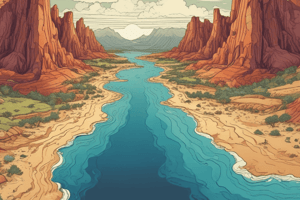Podcast
Questions and Answers
What is the primary focus of the theory of plate tectonics?
What is the primary focus of the theory of plate tectonics?
- The division of the Earth's crust into rigid plates (correct)
- The formation of ocean currents
- The movement of the Earth's atmosphere
- The impact of gravitational forces on landforms
Which aspect does the theory of continental drift primarily address?
Which aspect does the theory of continental drift primarily address?
- The erosion of mountains over millennia
- The expansion of the Earth's crust due to volcanic activity
- The historical movement of continents to form Pangea (correct)
- The sinking of oceanic plates into the mantle
What is the main driving force behind the expansion of the ocean floor according to its theory?
What is the main driving force behind the expansion of the ocean floor according to its theory?
- Pressure from the Earth's core (correct)
- The heat from the Sun
- The Earth's gravitational pull
- Tidal forces from the Moon
What did Alfred Wegener's theory suggest about the configuration of continents over time?
What did Alfred Wegener's theory suggest about the configuration of continents over time?
Which geological features are explained by the theory of plate tectonics?
Which geological features are explained by the theory of plate tectonics?
How is the motion of tectonic plates initiated?
How is the motion of tectonic plates initiated?
What is the primary reason why volcanic and seismic risks need to be considered in geographic discussions about plate tectonics?
What is the primary reason why volcanic and seismic risks need to be considered in geographic discussions about plate tectonics?
What is the name of the partially molten layer of the Earth beneath the tectonic plates?
What is the name of the partially molten layer of the Earth beneath the tectonic plates?
What is the name of the supercontinent that existed according to Alfred Wegener's theory of continental drift?
What is the name of the supercontinent that existed according to Alfred Wegener's theory of continental drift?
What is the process that creates new oceanic floor material, causing tectonic plates to move?
What is the process that creates new oceanic floor material, causing tectonic plates to move?
What type of zones are characterized by subduction zones and significant seismic activity?
What type of zones are characterized by subduction zones and significant seismic activity?
Why are tectonic plates considered rigid?
Why are tectonic plates considered rigid?
What is the main difference between the Circum Pacific Belt and the Circum Mediterranean Belt?
What is the main difference between the Circum Pacific Belt and the Circum Mediterranean Belt?
What is the ultimate goal of understanding plate tectonics and the associated risks?
What is the ultimate goal of understanding plate tectonics and the associated risks?
Study Notes
Global Tectonics
- Plate tectonics explains the Earth's surface modification and forms geological features like plains, plateaus, and mountains.
- The Earth’s crust is divided into rigid, constantly moving tectonic plates, influencing volcanic and seismic risk zones globally.
Theory of Continental Drift
- Proposed by Alfred Wegener in 1912, this theory suggests that continents were once joined in a supercontinent named Pangea.
- It provides an explanation for the movement of continents over geological time.
Theory of Seafloor Spreading
- Developed in the mid-20th century as a complement to continental drift.
- It posits that the ocean floor expands as pressure from the Earth's core causes cracks in the mantle, allowing magma to surface and drive tectonic plate movement.
Structure of the Earth's Lithosphere
- The lithosphere consists of rigid tectonic plates floating on a semi-fluid mantle layer.
- Understanding this structure is crucial for grasping plate tectonics and its movements.
Risk Zones
- Significant consideration of volcanic and seismic zones is necessary, particularly in regions like Mexico.
- Two primary risk areas include:
- Circum Pacific Belt (Ring of Fire): Known for subduction zones, resulting in high seismic activity, earthquakes, and volcanic eruptions.
- Circum Mediterranean Belt: Displays volcanic and seismic activity, though less severely compared to the Circum Pacific Belt.
Importance of Knowledge
- Understanding the dynamics of tectonic movements and risk zones is essential for disaster preparedness and risk mitigation in affected regions.
Studying That Suits You
Use AI to generate personalized quizzes and flashcards to suit your learning preferences.
Description
Learn about plate tectonics, its two main theories, and how they explain volcanic and seismic zones, as well as the formation of plains, plateaus, and mountains.




